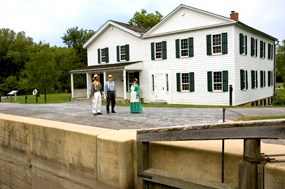|
The land that today makes up Cuyahoga Valley National Park has been home to humans for thousands of years. Native Americans were the first inhabitants. Different cultures hunted and built villages in the valley during different periods. By the middle 1700s, Europeans were establishing trading posts in the valley and a few decades later settlers from New England started coming to stay. Those frontier communities eventually became towns, their growth helped along by first the canal, then the railroad, and later interstate highways. 
© D.J. Reiser Native AmericansWhen Native American tribes seeking refuge arrived in the Ohio Country, they found relatively unoccupied land. The last permanent residents, the Whittlesey, had disappeared from the region in the early 1600s. Between the early 1600s and 1730, the valley had been used primarily as a transportation route for trade and hunting. Western Reserve PioneersA new kind of people began coming to the Cuyahoga Valley in the late 1700s. Families from Massachusetts, Connecticut, and other New England states had begun moving to the Western Reserve, including land around the Cuyahoga River. These New Englanders were not traders or missionaries. They were settlers looking to make a new life in the valley. 
NPS / Ted Toth Moses and Polly GleesonImagine leaving civilization for the wilderness. By 1818, Moses Gleeson and his wife Polly Richardson Gleeson had moved to Bedford, Ohio, at the edge of wilderness. Like many who came to the new state of Ohio looking for a better life, Mr. Gleeson was a farmer and a business man, farming and trying his hand at sawmilling, then at the tavern business. A business associate convinced him to purchase the property located at Lock 38 as an investment, speculating on the potential of the new Ohio & Erie Canal. Moses Gleeson bought the structure on the canal, then added to it to open it as both a tavern and a store. Eventually hard times found that tavern, and the building became a store, a residence, and a blacksmith shop, among other uses. The Gleeson family remained prominent in the area and in Bedford and in time Americanized the name to Gleason. For more of their story, visit Canal Exploration Center. |
Last updated: October 23, 2024
